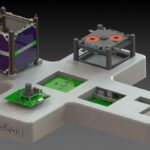Space-Comm Expo 2023, which took place at Farnborough International Exhibition and Conference Centre on 7-8 June, provided the ideal platform for start-ups to showcase innovative technologies set to revolutionise the space industry.
Extend Robotics demonstrated it VR-based teleoperations solution live on stand G30M, allowing visitors to get a feel for how this robotics technology can be used for remote maintenance and servicing as well as satellite docking tasks.
Nitish Sharma, cloud robotics lead, Extend Robotics, explained: “Our solution is different to traditional teleoperated arms which required 2D screens, clunky hardware and exoskeletons – with the VR-based system you can immerse yourself in the remote environment, which is rendered in real time with really low latency and low bandwith using our Sense Kit.”
The solution underwent a feasibility study last year with UK Space Agency and University of Surrey, where it was tested for low-orbit satellite docking and managed to get 95% success rate during the study.
Star tracking and space debris reduction
Meanwhile, Belgium start-up Arcsec presented its altitude determination and control systems and star trackers for the first time at Space Comm Expo.
“We make tools for satellite operators to determine where the satellite is pointing exactly and then easily and accurately change the orientation,” said Alexander Vandenberghe, AIV engineer, Arcsec. “We also specialise in star trackers which are mounted on the satellite and look at the stars to accurately determine where they are in relation to the earth – it is a more state-of-the-art version of what they used to do on the ships in the 1600s.”
The company is also exploring using its star trackers to detect and track space debris, and reduce congestion in orbit.
Developing metamaterials
Also at the event for the first time was the UK Metamaterials Network, a newly established body that brings together all universities working on metamaterials, industries interested in using metamaterials and policy makers.
Metamaterials can be engineered to have certain desired properties as opposed to naturally occurring materials that have fixed properties, such as response to temperature or light.
According to Simon Pope, lecturer at the network, the development of metamaterials and their uses has grown exponentially in the last two decades but there is more to be done. “The concept of the metamaterial was created by the UK and USA 25 years ago, and it is one of those things that has a huge amount of potential over the next 20 years to provide new capabilities that you can’t have in existing devices,” he commented. “We’re at the phase now where there is a lot of lab-based work and prototyping work, but it needs to be translated into commercial work.”
Subscribe to the FINN weekly newsletter

